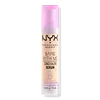What's inside
What's inside
 Key Ingredients
Key Ingredients

 Benefits
Benefits

 Concerns
Concerns

No concerns
 Ingredients Side-by-side
Ingredients Side-by-side

Water
Skin ConditioningHydrogenated Polyisobutene
EmollientHydrogenated Polydecene
EmollientPolyglyceryl-3 Diisostearate
EmulsifyingGlycerin
HumectantTrimethylsiloxysilicate
EmollientIsononyl Isononanoate
EmollientDisteardimonium Hectorite
StabilisingButylene Glycol
HumectantSilica
AbrasiveCamellia Sinensis Leaf Extract
AntimicrobialHelianthus Annuus Seed Oil
EmollientTremella Fuciformis Polysaccharide
Emulsion StabilisingCentella Asiatica Extract
CleansingAllantoin
Skin ConditioningSorbitan Olivate
EmulsifyingSorbitan Sesquiisostearate
EmulsifyingGlyceryl Behenate/Eicosadioate
EmollientSodium Chloride
MaskingMagnesium Sulfate
Ethylhexylglycerin
Skin ConditioningPolyhydroxystearic Acid
EmulsifyingTocopherol
AntioxidantPhenoxyethanol
PreservativeCI 77491
Cosmetic ColorantCI 77492
Cosmetic ColorantCI 77499
Cosmetic ColorantCI 77891
Cosmetic ColorantCeramide AP
Skin ConditioningWater, Hydrogenated Polyisobutene, Hydrogenated Polydecene, Polyglyceryl-3 Diisostearate, Glycerin, Trimethylsiloxysilicate, Isononyl Isononanoate, Disteardimonium Hectorite, Butylene Glycol, Silica, Camellia Sinensis Leaf Extract, Helianthus Annuus Seed Oil, Tremella Fuciformis Polysaccharide, Centella Asiatica Extract, Allantoin, Sorbitan Olivate, Sorbitan Sesquiisostearate, Glyceryl Behenate/Eicosadioate, Sodium Chloride, Magnesium Sulfate, Ethylhexylglycerin, Polyhydroxystearic Acid, Tocopherol, Phenoxyethanol, CI 77491, CI 77492, CI 77499, CI 77891, Ceramide AP
Caprylic/Capric Triglyceride
MaskingBis-Diglyceryl Polyacyladipate-2
EmollientCetyl Alcohol
EmollientVp/Hexadecene Copolymer
Silica Dimethyl Silylate
EmollientAluminum Hydroxide
EmollientAscorbyl Palmitate
AntioxidantPassiflora Edulis Seed Oil
EmollientTocopherol
AntioxidantMicrocrystalline Wax
Emulsion StabilisingPhenoxyethanol
PreservativeTocopheryl Acetate
AntioxidantCaprylyl Glycol
EmollientKaolin
AbrasiveCI 77891
Cosmetic ColorantIron Oxides
Caprylic/Capric Triglyceride, Bis-Diglyceryl Polyacyladipate-2, Cetyl Alcohol, Vp/Hexadecene Copolymer, Silica Dimethyl Silylate, Aluminum Hydroxide, Ascorbyl Palmitate, Passiflora Edulis Seed Oil, Tocopherol, Microcrystalline Wax, Phenoxyethanol, Tocopheryl Acetate, Caprylyl Glycol, Kaolin, CI 77891, Iron Oxides
 Reviews
Reviews

Ingredients Explained
These ingredients are found in both products.
Ingredients higher up in an ingredient list are typically present in a larger amount.
Ci 77891 is a white pigment from Titanium dioxide. It is naturally found in minerals such as rutile and ilmenite.
It's main function is to add a white color to cosmetics. It can also be mixed with other colors to create different shades.
Ci 77891 is commonly found in sunscreens due to its ability to block UV rays.
Learn more about CI 77891Phenoxyethanol is a preservative that has germicide, antimicrobial, and aromatic properties. Studies show that phenoxyethanol can prevent microbial growth. By itself, it has a scent that is similar to that of a rose.
It's often used in formulations along with Caprylyl Glycol to preserve the shelf life of products.
Tocopherol (also known as Vitamin E) is a common antioxidant used to help protect the skin from free-radicals and strengthen the skin barrier. It's also fat soluble - this means our skin is great at absorbing it.
Vitamin E also helps keep your natural skin lipids healthy. Your lipid skin barrier naturally consists of lipids, ceramides, and fatty acids. Vitamin E offers extra protection for your skin’s lipid barrier, keeping your skin healthy and nourished.
Another benefit is a bit of UV protection. Vitamin E helps reduce the damage caused by UVB rays. (It should not replace your sunscreen). Combining it with Vitamin C can decrease sunburned cells and hyperpigmentation after UV exposure.
You might have noticed Vitamin E + C often paired together. This is because it is great at stabilizing Vitamin C. Using the two together helps increase the effectiveness of both ingredients.
There are often claims that Vitamin E can reduce/prevent scarring, but these claims haven't been confirmed by scientific research.
Learn more about Tocopherol